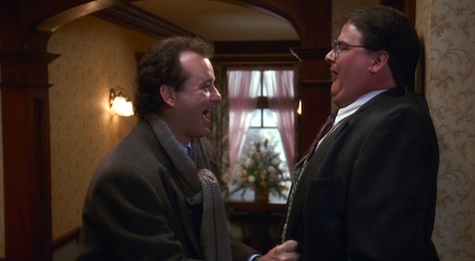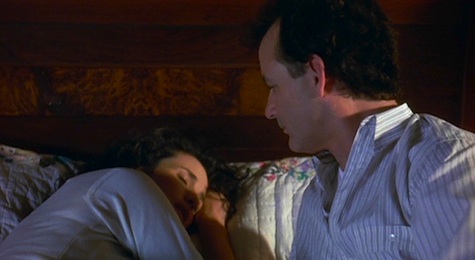What day is it, again?
Groundhog Day, the 1993 Bill Murray time travel movie, is one of those films that stands the test of time politely. It’s not quite a cult film, with devoted fan bases and a lot of tie-in activities, rather it’s a film that’s more quietly respected. You saw it when it came out (most likely), you found it to be entertaining (again, most likely), it left you wondering what you’d do in the same situation, and you kind of left it at that. Groundhog Day isn’t one of those lost gems of pop culture, it’s more of a pleasant memory.
Nearly twenty years later our hunger for sophisticated and fun time travel fiction is as large as ever, and sated far more often than it was in the early 1990s. So with the uniqueness of the premise somewhat dulled, and without the glaze of nostalgia, does a film like Groundhog Day still hold up?
The answer to such a question is a surprising yes. Not surprising in that the answer was yes in the first place, but surprising in how immediately the movie makes this apparent. This is a solidly built film, bursting with character, comedy, and theme. This is high concept storytelling made very personable and engaging.
The story begins with Pittsburgh weatherman Phil Conners, a terribly egotistical ass who always has a snide remark for the world around him. He hates the city he lives in, he hates being assigned to do anything, he hates his cameraman (played by Chris Elliott, who doesn’t really give the viewer a reason to not hate him), and he thinks his show’s new producer Rita is a total rube.

The crew is headed to Punxsatawney, Pennsylvania to film the Groundhog Day celebrations. (For those unaware, Punxsatawney is actually the mecca—as far as meccas go—of groundhog-related weather-predicting events. The town gears up for this every year.) Phil sees little point in celebrating a holiday that he sees as geared towards rednecks and grumbles his way through the entire celebration.
It would be a pretty dour film if it was just us watching an asshole getting forced through his life, but it’s not a dour film at all, mostly due to the setting of Punxsatawney itself. Bill Murray’s character can barely take a step without a colorful townsperson being shot at him, the most obnoxious of which is Ned Ryerson, an insurance salesman who immediately invades Phil’s personal space, is constantly touching him inappropriately, and throws catchphrases at him at a rapid-fire pace. Stephen Tobolowsky plays this role to the absolute hilt, delivering a tour-de-force of memorable character acting in less than two minutes. Watching this for the first time I had the same reaction Phil does in the film, watching this again just leaves me astounded at how precisely calculated Tobolowsky’s performance is.

Ned is just the first of many residents that Phil (and the viewer) will get to know, and here is where the movie really starts getting clever. At first glance we’re just getting a series of gags and bits designed to tweak at Bill Murray’s character, little realizing that we’re actually getting a deeply colorful impression of the town itself. This turns out to be critically central to the plot, and key to the emotional pay-off of the entire film. Punxsatawney itself rivals Phil as the most important character in the movie.
And Phil will explore this town exhaustively, from the B&B staff, to the psychiatrist, to the town’s top-hatted leaders, to the bums in the bowling alley, to Nancy, to the piano teacher, to Dora, to Ned, to the homeless guy he always passes onward and onward. Nearly every person he meets ends up figuring into his journey.



It’s interesting to watch Groundhog Day again while knowing the broad phases that Bill Murray is going to go through. He’s disbelieving at first and takes a logical approach, trying to reason his problem out, then seeking professional help from both a neurosurgeon (Harold “Egon” Ramis in a cameo) and the town’s awful therapist, a man who can’t stop shaking with nervousness even when he appears to be speaking calmly.
Around his fourth run-through of Groundhog Day, he starts having fun with his predicament. He eats through an entire table piled with breakfast, punches Ned because he can, times a perfect robbery of an armored car, and goes on a drunken bender with a couple of guys from the bowling alley. A bender which ends with Phil driving them on to the railroad tracks and facing down an oncoming train. (“I think they’re going to swerve FIRST,” he slurs while driving towards the train.)

He continues to toy with his environment, spinning off scores of alternate timelines as his loop continues. He soon steps up his game and starts seducing women in town, learning about their lives on a first pass, then hitting on them in a latter loop with that foreknowledge. It’s almost too easy for him.


So easy, in fact, that he eventually turns his sights on Rita, Andie MacDowell’s character. At first, Phil desires her because she consistently refuses to warm to him like other women he’s picked up in town; she’s the last person not interested in him. He ends up having to run through a day with her countless times, learning more about her each time, until a bond genuinely forms. (It actually turns into a bit of a parable for dating in general. i.e. the more you respect the other party as a fellow human being, the more successful the bond formed through the date.)
The movie falters a little here, mainly due to how thinly sketched MacDowell’s character is. At one point Phil straight up asks her what she’s looking for in a man and she basically combines the stereotypes of a romance novel model and a southern gentleman without a trace of humor or insistence. She seems to have no actual real life basis for what she wants and later admits she’s just “going with the flow.” Since she has no specific desire, it’s difficult to believe that Phil’s attracted to her in any way aside from his need to prove that he can do anything. (As long as there are no consequences.)
The film reverts back to Phil’s narcissism at this point, though, allowing him to get really close to bedding Rita through a very fine-tuned approach, but never close enough. Every variation he tries always ends with him getting slapped.
It’s then that he decides that he’s had his fun, he’s spent a minimum of 40 days (probably longer) in this loop, so he proceeds to kill himself and the groundhog in hopes that it will break the cycle.

The first attempt doesn’t work, he just wakes up back in bed, so he immediately tries again.

And again.

When the montage of death is over, he reveals that he’s been at this for at least 6 months, probably more. This is when he actually begins to make headway towards a solution. He convinces Rita during one loop that he’s actually trapped in time, so she starts watching him “like a science experiment.” This equal fascination between the two, this easy give-and-take, actually succeeds in getting Rita to care for him and Phil, for the first time, acts genuinely noble towards her and doesn’t take advantage of the situation. In terms of his personal maturity, Phil has already run through every thing he’s had the desire to do, leading him to seriously consider the kind of person he wants to be and the kind of life he really wants to live. He sees a kind and goodhearted person in Rita and he is astounded that someone like that could, possibly, see the same in him. The quiet transformation is very affecting. Bill Murray pulls off a hell of a performance here, completely selling their relationship to the viewer.

But still, he wakes up back at the beginning.
However, he’s not defeated this time. If she could see a good person in him then, he now knows, it’s probably there. He lives his life in this regard as he continues to loop through the same day. He cares for the homeless resident (to no avail, but he keeps trying), he quits phoning it in during his broadcast, he works on personal skills he’s always wanted to develop. Slowly, ever so slowly, he constructs a timeline in his head of where in Punxsatawney and when someone like him is urgently needed.
We continue looping with Phil until finally we see the fruits of this growth collected into a single day. He saves a kid falling from a tree, he fixes a flat tire almost before the driver knows it’s gone flat, he saves the mayor from choking on steak, he convinces a young couple to go ahead with their marriage, and he plays some lively piano for the townspeople at a party. He even makes creepy, creepy Ned Ryerson happy.

This is, of course, the key that finally unlocks Phil from the Groundhog Day time loop. He’s spent a lot of time figuring out how to fulfill his own desires, but it’s not until he begins addressing the desires of the people around him, including Rita, that he’s seen fit to be released. The townspeople who assaulted him in the beginning with various bits and gags? He had to step outside of himself and see them as real people, and he had to grow into this behavior genuinely, in order to continue with his own life. Because before Groundhog Day, continuing with his own life was a bitter proposition for all involved.
The lesson is an obvious one by the end of the film, but it’s amazing to see how Groundhog Day gets there. The structure of the movie, the use of its characters and settings, seem haphazard but betray a meticulousness upon repeat viewings. Everything is foreshadowed (even the solution, in the form of a family crest with the word “Unselfishness” hanging in the B&B in the beginning of the film) and nothing is wasted. This is a tightly woven presentation. A time travel movie that, oddly enough, wastes no time in telling its story. Further, it manages to be a primarily comic vehicle that realistically portrays the emotional toll someone caught in a time loop would suffer through. Phil goes through very distinct stages of grief, and acts out in ways that the viewer could see themselves acting were they caught in such a unique situation. There isn’t a lick of science in this film, no reason given for the loop, it’s just there and because the character drama and ensemble acting within it is so strong, you simply accept it.
As far as nostalgia trips go, Groundhog Day is definitely worth watching again. The quality you recall remains in the film and Bill Murray is relentlessly funny. I can’t recall another film of his where he lands so many good lines.
But this being Groundhog Day and all, you already knew that, didn’t you?
Check out Tor.com’s other Groundhog Day-related items from today:
- Re-Living Your Own Life: Ken Grimwood’s Replay
- Bill Murray Makes Any Science Fiction Film Better
- Should Groundhog Day Become a Holiday For Time Travel?
Chris Lough is the production manager of Tor.com and often revisits days. Except Miracle Day. Ugh.










